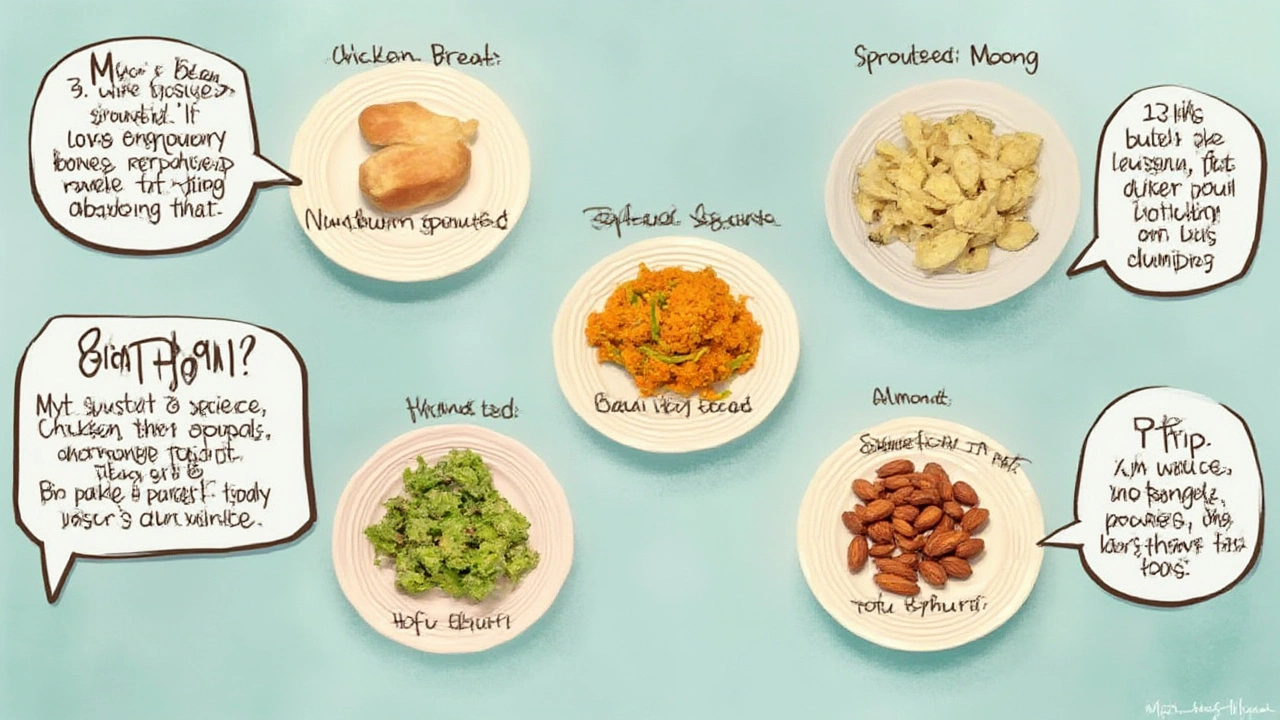Best Protein Sources for Belly Fat Loss: What Actually Works?
 Jul, 28 2025
Jul, 28 2025
Belly fat isn’t just stubborn—it can also be dangerous. Visceral fat, the kind packed around your organs, raises your risk for diabetes and heart disease. That puts pressure on anyone trying to shed a few centimetres. At every gym, in every diet group online, there’s a fierce debate: which protein helps most with getting that waistline to shrink? Not all proteins are created equal. Want the real story, minus the marketing hype?
How Protein Impacts Belly Fat: The Science, Not the Hype
So, how does eating more protein actually help you tackle belly fat? It starts with appetite. Research from the University of Sydney found that people who boosted their protein intake naturally ate less throughout the day—no willpower needed. Protein triggers the release of satiety hormones like GLP-1 and PYY, both of which signal to your brain that you’re full. Compare that to a typical carb-heavy breakfast and you’re way less likely to run for a 3 pm muffin.
Now, here’s where things get interesting. Protein is also the macronutrient with the highest thermic effect—your body burns about 20-30% of protein calories just digesting it, compared to only 5-10% for carbs or 0-3% for fat. That means if you eat a 200-calorie chicken breast, roughly 40-60 calories are torched just processing it. Not bad, right?
But protein doesn’t just help with burning more calories. It also preserves lean muscle when you’re losing weight. Why does this matter for belly fat? Lean muscle ups your daily calorie burn even when you’re lounging on the couch, which cranks up your fat loss pace. Studies published in the American Journal of Clinical Nutrition repeatedly show that people who keep their protein higher while cutting calories tend to lose more belly fat and keep it off better in the long run.
Belly fat is also especially stubborn for people who yo-yo diet or lose weight rapidly and regain it. Quality protein protects your muscle, lowers cravings, and may even reduce the "rebound" effect. Take it from studies tracking folks over a year: higher-protein diets led to twice as much belly fat loss compared to low-protein plans, even when calorie intake was similar.
But here’s the catch. You need your protein in smart doses. Slamming down shakes won’t magic away a belly overnight. Spreading protein through your meals—think 20-30 grams at breakfast, lunch, and dinner—helps your body use it for satiety and muscle protection all day long. And not all sources work equally well, which brings us to the food itself.
Animal vs. Plant Protein: Which Is Better for Slimming Your Waist?
Think protein, and you probably picture eggs or chicken breast. Animal protein is the gold standard for a reason: it contains all nine essential amino acids needed for muscle repair. But plant protein is everywhere lately, from pea protein shakes to lentil pasta. Does the source make a difference for belly fat loss?
Animal-based proteins—like lean beef, chicken, eggs, Greek yogurt, and fish—boast high "biological value," meaning your body absorbs and uses them efficiently. One Aussie study from 2022 compared women eating nothing but plant-based protein versus those on mixed animal-plant diets. The mixed group lost more waist fat over 12 weeks, especially those eating more fish—rich in omega-3s, which play a unique role in fighting abdominal fat. High-protein dairy like Greek yogurt or cottage cheese also scored high for belly fat loss, thanks to their calcium, which helps regulate fat storage around the waist.
But it’s not all bad news for plant lovers. Eating a variety—beans, tofu, lentils, seeds—can cover your protein bases. Just be aware that most plant foods don’t have the complete amino acid profile unless combined. Mix brown rice with beans, hummus with wholegrain toast, or tempeh with quinoa. A large-scale study from Harvard that tracked 120,000 adults over 16 years found that increasing plant protein (when paired right) led to significant fat loss. But, most people had to eat bigger portions to match the muscle-preserving effects of animal protein, so calorie control became trickier.
Whey protein powder deserves a special mention. It’s a dairy-based protein that digests quickly and spikes satiety. In a meta-analysis, people using whey lost an extra 2–6 pounds of fat (mostly abdominal) over 12 weeks compared to a placebo, even when both groups ate the same overall calories. Not into dairy? Look for pea or soy protein isolate for a similar effect.
| Protein Source | Grams per 100g | Thermic Effect | Notable Benefits |
|---|---|---|---|
| Chicken breast | 31g | High | Low fat, complete amino acids |
| Egg (whole) | 13g | High | High satiety, easy to cook |
| Salmon | 25g | High | Omega-3s fight belly fat |
| Greek yogurt | 10g | Medium | Gut health, calcium |
| Lentils | 9g | Medium | High fibre, vegan |
| Tofu | 8g | Medium | Complete amino acid in soy |
| Pea protein powder | 80g | High | Vegan, mixes well in shakes |
Instead of picking one "perfect" protein, the answer is a little boring but a lot more effective: variety works. Aim for at least one high-protein food in every meal. If you prefer animal options, try to keep it lean and watch portion sizes. If you’re going mainly plant-based, combine your sources to ensure you’re getting a full amino acid profile for muscle retention and satiety.

Common Protein Myths That Make Belly Fat Loss Harder
So many myths fly around when it comes to protein and fat loss. First up, “More is better.” Not true. Your body can’t use endless protein, and too much can stress your kidneys—especially if you already have a condition. Most research says shoot for 1.6–2.2 grams per kg of bodyweight per day if you're active and aiming for fat loss. For someone who’s 70kg, that’s about 112–154g daily, spread over three or four meals.
Myth two: “Don’t worry about the protein sources—powders are just as good as food.” Wrong again. Powders are super convenient for hitting those protein targets and recovering fast after sessions, but they don’t have the same range of nutrients found in whole foods. Fish, eggs, and legumes also deliver antioxidants, vitamins, and minerals that help you stay full and healthy. Don’t neglect the humble chickpea just because whey powder is quick.
Ever heard the one about protein being hard on your liver or bones? Unless you already have advanced kidney disease, eating more protein than the RDI (recommended daily intake) isn't dangerous for healthy people, according to systematic reviews published in the Journal of Nutrition in 2024. In fact, higher protein diets can help older adults build and keep lean mass—good news for anyone over thirty as metabolism naturally slows.
Another tall tale: “You have to eat all your protein at dinner or right after working out.” Small bump for post-gym recovery, sure. But for appetite and muscle maintenance, spreading protein across breakfast, lunch, and dinner is smarter. Skipping protein at breakfast (hello, sugary cereal) is a huge missed opportunity. Squeeze in just two eggs or a pot of Greek yogurt and the satiety benefits kick in before you even hit midday cravings.
And finally, the myth that only athletes or gym rats need this much protein. You don’t have to bench press twice your weight to earn the right to high-quality protein. If you’re aiming for fat loss and a flatter belly, you’ll lose less muscle and burn more kilojoules daily just by reaching that sweet spot in your diet.
Real-World Tips: Winning the Daily Protein Game for Fat Loss
Now to the stuff that actually matters when you’re standing in your own kitchen. What does a day of belly-fat-friendly protein even look like? Don’t get obsessed with grams—look instead at your plate. Aim for a palm-sized portion of protein at each main meal if you’re a woman, or two palms if you’re a guy.
Here’s an easy checklist to put straight to work in your next shop:
- Breakfast: Swap sugary cereal for a three-egg omelette with spinach and feta, or Greek yogurt (150g) with berries and kangaroo muesli (you can thank Sydney’s healthy food culture for that last one).
- Lunch: Load up on salad, sure, but pile on 100g grilled chicken, a tin of tuna, or a hearty cup of black beans.
- Snack: Keep hard-boiled eggs, cottage cheese, or a protein shake on hand. For plants, edamame or chickpea hummus with veggie sticks are both smart picks.
- Dinner: Stir-fry lean beef or tofu with heaps of veggies, or go for wild-caught salmon with a side of roasted pumpkin and lentils. Extra points for adding hemp or chia seeds to salads, as they sneak in bonus protein (and you barely taste them).
Timing can help, but don’t obsess. If you train in the morning, a protein-rich meal straight after will help with sore muscle repair. Not training? Spread your protein through the day—don’t smash it all at once, or you’ll miss those hunger-curbing benefits.
Keep things flexible. If you’re vegan, rely on combos: peanut butter on multigrain toast, tofu in stir-fries, or mixed bean salads topped with pumpkin seeds. Carnivore? Keep red meat to just two or three times a week and bust out the fish twice for those omega-3s. Dairy fans can blend Greek yogurt with fruit or have a glass of milk with dinner. Local tip: In Sydney’s winter, slow-cooked lentil or chicken soup is both filling and perfect for meal prep.
One practical way to avoid protein fatigue (and calorie creep) is meal prepping once a week. Batch cook proteins—grilled chicken, boiled eggs, chickpea patties—that can be tossed onto salads, tucked into wraps, or added to Power Bowls whenever needed. Use herbs, spices, and a squirt of fresh lemon to keep things exciting instead of sodium-laden sauces.
For dessert (yes, you can have dessert), try cottage cheese with passionfruit or apples with a tablespoon of almond butter. Sweet and satisfying, and loaded with protein to fend off late-night munchies.
So, what’s the secret? There isn’t a single protein for belly fat that works for everyone. But by focusing on variety, keeping portions steady, and lining up your daily meals with your lifestyle, you can steadily chip away at stubborn belly fat and protect your health for the long run. Giveaway tip? If you’re feeling hungry or struggling with cravings while trying to lose your belly, it’s almost always because you aren’t getting enough protein at breakfast or lunch. Make that one tweak, and the rest often falls into place—no fads, no “magic” solutions required.
